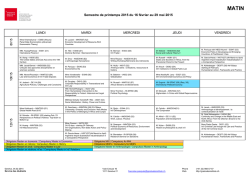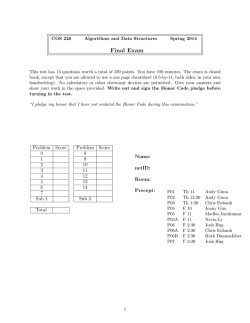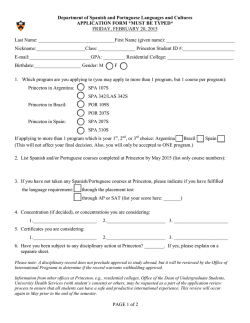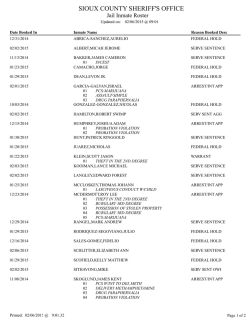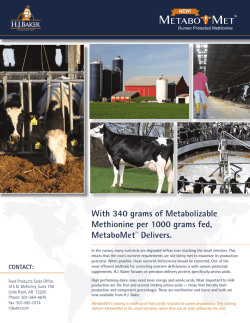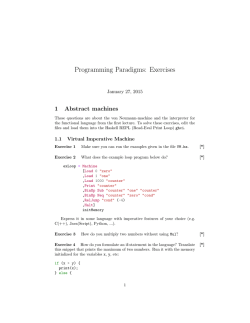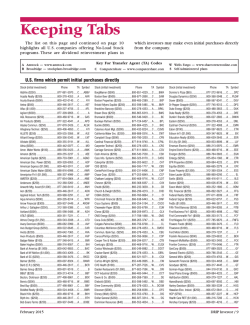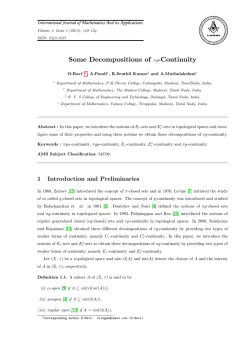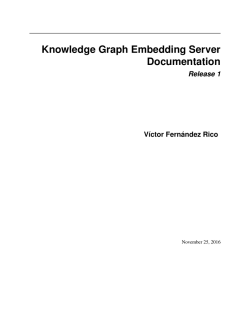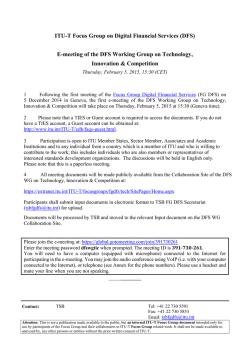
Final - Princeton University
COS 226
Algorithms and Data Structures
Spring 2012
Final
This test has 14 questions worth a total of 100 points. You have 180 minutes. The exam is closed
book, except that you are allowed to use a one page cheatsheet (8.5-by-11, both sides, in your own
handwriting). No calculators or other electronic devices are permitted. Give your answers and
show your work in the space provided. Write out and sign the Honor Code pledge before
turning in the test.
“I pledge my honor that I have not violated the Honor Code during this examination.”
Problem Score
0
1
2
3
4
5
6
Sub 1
Problem Score
7
8
9
10
11
12
13
Sub 2
Name:
Login ID:
Precept:
P01
P01A
P01B
P02
P03
P04
P04A
Total
May 21: 14322d023dc5eda4
1
Th 12:30
Th 12:30
Th 12:30
Th 1:30
Th 3:30
F 11
F 11
Diego Botero
David Shue
Joey Dodds
Josh Hug
Josh Hug
Joey Dodds
Jacopo Cesareo
2
PRINCETON UNIVERSITY
0. Initialization. (1 point)
Write your name and Princeton NetID in the space provided on the front of the exam; circle
your precept number; and write and sign the honor code.
1. Analysis of algorithms. (10 points)
(a) Suppose that you observe the following running times for an operation on a data structure
with N items.
N
time
10,000
1.2 seconds
40,000
2.1 seconds
160,000
3.9 seconds
640,000
7.9 seconds
2,560,000
16.0 seconds
Estimate the running time of the operation (in seconds) as a function of N and use tilde
notation to simplify your answer. Circle your answer.
(b) Consider the following data structure for representing a ternary search trie in Java.
public class TST<Value> {
private Node root;
private class Node {
private char c;
private Node left, mid, right;
private Value val;
}
...
// root of TST
//
//
//
//
inner class
character
left, middle, and right subtries
value associated with string
}
Suppose that you have a TST object with N key-value pairs, comprised of M Node
objects. Using the 64-bit memory cost model from the textbook, how much memory (in
bytes) does the object use as a function of M and N ? Assume that the Value type is
Integer—each Integer object uses 24 bytes. Simplify your answer using tilde notation.
COS 226 FINAL, SPRING 2012
3
(c) For each function on the left, give the best matching order of growth of the running time
on the right. You may use an answer more than once or not at all.
−− B−−
−−−−−
−−−−−
public static int f1(int N) {
int x = 0;
for (int i = 0; i < N; i++)
x++;
return x;
}
A. log N
public static int f2(int N) {
int x = 0;
for (int i = 0; i < N; i++)
for (int j = 0; j < i; j++)
x += f1(j);
return x;
}
D. N 2
public static int f3(int N) {
if (N == 0) return 1;
int x = 0;
for (int i = 0; i < N; i++)
x += f3(N-1);
return x;
}
G. 3N
B. N
C. N log N
E. N 3
F. 2N
H. N !
−−−−−
public static int f4(int N) {
if (N == 0) return 0;
return f4(N/2) + f1(N) + f1(N) + f1(N) + f4(N/2);
}
−−−−−
public static int f6(int N) {
if (N == 0) return 1;
return f6(N-1) + f6(N-1) + f6(N-1);
}
−−−−−
public static int f7(int N) {
int x = 0;
while (N > 0) {
x++;
N = N / 2;
}
return x;
}
4
PRINCETON UNIVERSITY
2. Miscellaneous. (9 points)
Match each task on the left with the best-matching description on the right. For the purposes
of this question, assume P 6= N P .
−−−−−
Construct a DFA corresponding to a regular expression.
−−−−−
Construct an NFA corresponding to a regular expression.
A. Can be solved in
linear time in the
worst case.
B. Can be solved in
polynomial time
in the worst case.
−−−−−
Compress the strict majority of 10MB files by more than
3 bits.
−−−−−
Find a longest path from s to t in an edge-weighted DAG.
C. Can be solved in
exponential time
in the worst case.
−−−−−
Find a longest path from s to t in an edge-weighted digraph.
D. Impossible.
−−−−−
Compute a maximum s-t flow in a flow network using the
Ford-Fulkerson algorithm with the shortest augmenting
path rule.
−−−−−
Compute a minimum s-t cut in a flow network given a
maximum s-t flow.
−−−−−
Determine whether a digraph is a DAG.
−−−−−
Enumerate all subsets of a set of size N such that every
pair of adjacent subsets differs in exactly one item.
−−−−−
Find the longest key in an R-way trie that is a prefix of
a query string.
COS 226 FINAL, SPRING 2012
5
3. Graph search. (8 points)
DFS/BFS, Spring 2012
Consider the following digraph. Assume the adjacency lists are in sorted order: for example,
when iterating through the edges pointing from 0, consider the edge 0 → 1 before 0 → 2 or
0 → 6.
1
2
4
0
6
8
7
5
3
(a) Run depth-first search on the digraph, starting from vertex 0. List the vertices in reverse
postorder.
0
___
___
___
___
___
___
___
___
___
(b) Run breadth-first search on the digraph, starting from vertex 0. List the vertices in the
order in which they are dequeued from the FIFO queue.
0
___
___
___
___
___
___
___
___
___
6
PRINCETON UNIVERSITY
Minimum
4. Minimum spanning trees.
(8 points) Spanning
Tree, Spring 2012
Consider the following edge-weighted graph with 9 vertices and 19 edges. Note that the edge
weights are distinct integers between 1 and 19.
F
1
15
14
5
D
6
13
16
I
4
9
18
17
A
19
10
E
7
8
G
11
B
2
3
H
C
12
(a) Complete the sequence of edges in the MST in the order that Kruskal’s algorithm includes
them (by specifying their edge weights).
1
____
____
____
____
____
____
____
____
(b) Complete the sequence of edges in the MST in the order that Prim’s algorithm includes
them (by specifying their edge weights), starting from vertex A.
4
____
____
____
____
____
____
____
____
COS 226 FINAL, SPRING 2012
7
5. Shortest paths. (8 points)
Suppose that you are running Dijkstra’s algorithm on the edge-weighted digraph (below left),
starting from a source vertex s. The table (below right) gives the edgeTo[] and distTo[]
values immediately after vertex 7 has been deleted from the priority queue and relaxed.
edge
weight
edge
weight
0→2
6.0
5→7
10.0
0→4
6.0
5→8
0→5
17.0
2→7
v
distTo[]
edgeTo[]
4.0
0
∞
null
6→0
12.0
1
12.0
5→1
6.0
6→1
3.0
3→0
1.0
6→2
1.0
2
1.0
5→2
3→1
25.0
6→3
17.0
3
∞
null
3→6
13.0
6→4
9.0
4
3.0
5→4
3→8
9.0
6→9
4.0
4→5
3.0
6 → 10
4.0
5
0.0
null
4→6
4.0
7→5
11.0
6
7.0
4→6
4→7
3.0
7→9
6.0
4→8
7 → 10
7
7.0
6.0
4→7
1.0
4→9
15.0
8→9
13.0
8
4.0
5→8
5→1
12.0
9→3
4.0
9
12.0
7→9
5→2
1.0
10 → 3
5.0
5→4
3.0
10 → 9
2.0
10
13.0
7 → 10
(a) Give the order in which the first 5 vertices were deleted from the priority queue and
relaxed.
7
(b) Modify the table (above right) to show the values of the edgeTo[] and distTo[] arrays
immediately after the next vertex has been deleted from the priority queue and relaxed.
Circle those values that changed.
8
PRINCETON UNIVERSITY
6. String sorting. (6 points)
Consider running LSD string sort on the input array a[] of 20 strings. Give the contents of
the array a[] immediately after the fourth call to key-indexed counting for the indices 0–5
and 15–19.
i
a[i]
(input)
i
a[i]
(fourth)
0
heard
0
1
beard
1
2
cable
2
3
cache
3
4
scald
4
5
scale
5
6
medic
6
badge
7
table
7
not required
8
badge
8
not required
9
weave
9
not required
10
heave
10
not required
11
hedge
11
not required
12
fable
12
not required
13
leave
13
not required
14
wedge
14
leave
15
ledge
15
16
media
16
17
rabid
17
18
sable
18
19
scare
19
COS 226 FINAL, SPRING 2012
9
7. Substring search. (6 points)
Below is a partially-completed Knuth-Morris-Pratt DFA for a string s of length 12 over the
alphabet { A , B, C }. Reconstruct the DFA and s in the space below.
0
1
2
3
4
5
6
7
8
9
10
A
5
7
1
9
11
B
0
0
8
0
0
0
0
4
0
10
0
A
A
B
A
C
A
C
s
0
11
C
Final, Fall 2011PRINCETON UNIVERSITY
10
8. Regular expressions. (6 points)
Suppose that we run the RE-to-NFA construction algorithm from the lecture and textbook
on the regular expression ( A ( B * | C ) * ). The match transitions are shown below.
0
1
2
3
4
5
6
7
8
9
(
A
(
B
*
|
C
)
*
)
Circle which one or more of the following edges are in the -transition digraph.
2→5
2→6
2→7
2→8
3→4
3→5
3→6
3→7
4→3
4→4
4→5
4→6
5→6
5→7
5→8
5→9
8→2
8→3
8→7
8→9
10
COS 226 FINAL, SPRING 2012
11
9. Ternary search tries. (6 points)
Suppose that the following set of 11 strings are inserted into a TST (in some order).
CANNON
CAP
CHARTER
CLOISTER
COLONIAL
IVY
QUAD
TERRACE
TIGER
TOWER
COTTAGE
(a) Suppose that the strings are inserted into the TST in alphabetical order. What is the
height of the resulting TST? (The height of a 1-node TST is 0.) Circle your answer.
(b) Suppose that the strings are inserted into the TST in an order which minimizes the
height. What is the height of the resulting TST? Circle your answer.
12
PRINCETON UNIVERSITY
10. Burrows-Wheeler transform. (8 points)
(a) What is the Burrows-Wheeler transform of the following?
A
B
C
C
C
B
C
B
(b) What is the Burrows-Wheeler inverse transform of the following?
5
B
B
C
C
C
D
A
A
B
Final, Fall 2012
COS 226 FINAL, SPRING 2012
13
11. Maximum flow. (8 points)
Consider the following st-flow network and feasible flow f .
1
9/9
4
flow
capacity
9
0/6
19 / 19
2
9
s
9
/
/
12
5/5
3
0
/7
14 / 15
0
/6
14 / 16
9
0 / 15
5
0/5
/
10
14 / 16
14
/
t
14
6
(a) What is the value of the flow f ?
(b) Perform one iteration of the Ford-Fulkerson algorithm, starting from the flow f .
Give the sequence of vertices on the augmenting path.
(c) What is the value of the maximum flow?
(d) List the vertices on the s side of the minimum cut.
(e) What is the capacity of the minimum cut?
14
PRINCETON UNIVERSITY
12. Algorithm design. (8 points)
Given an edge-weighted digraph G the bottleneck capacity of a path is the minimum weight
of an edge on the path.
For each part below, give a crisp and concise English description of your algorithm in the space
provided. Your answer will be graded on correctness, efficiency, clarity, and conciseness.
(a) Given an edge-weighted digraph G, two distinguished vertices s and t, and a threshold
value T , design an algorithm to find any one path from s to t of bottleneck capacity
greater than or equal to T or report that no such path exists. The order of growth of
the worst case running time of your algorithm should be E + V .
(b) Using the subroutine from (a), design an algorithm to find a maximum bottleneck capacity
path from s to t in an edge-weighted digraph G. The order of growth of the worst case
running time of your algorithm should be (E + V ) log E.
13. Reductions. (8 points)
• 3Sum. Given an integer array a[], are there three indices (not necessarily distinct) i,
j, and k such that a[i] + a[j] + a[k] == 0 ?
• 3Linear. Given an integer array b[], are there three indices (not necessarily distinct)
i, j, and k such that b[i] + b[j] = 8*b[k] ?
(a) Show that 3Linear linear-time reduces to 3Sum. To demonstrate your reduction, give
the 3Sum entries that would be constructed corresponding to the 3Linear instance:
b[]
b[0]
b[1]
b[2]
b[3]
b[4]
a[]
Hint: define M equal to 1 + maximum absolute value of any integer in b[].
(b) Suppose that Alice discovers an N 1.9 algorithm for 3Sum and Bob discovers an N 1.5
lower bound for 3Linear. Which of the following can you infer from the fact that
3Linear linear-time reduces to 3Sum ?
I. There does not exist a N 1.4 algorithm for 3Sum.
II. 3Sum and 3Linear have the same asymptotic complexity.
III. There exists an N 1.9 algorithm for 3Linear.
(a) I only.
(d) I, II and III.
(b) I and II only.
(e) None.
(c) I and III only.
15
© Copyright 2026
